Make our juicy slow-roasted turkey breast oven-baked to perfection. This delicious turkey breast recipe is perfect for a small gathering or a cozy family meal.
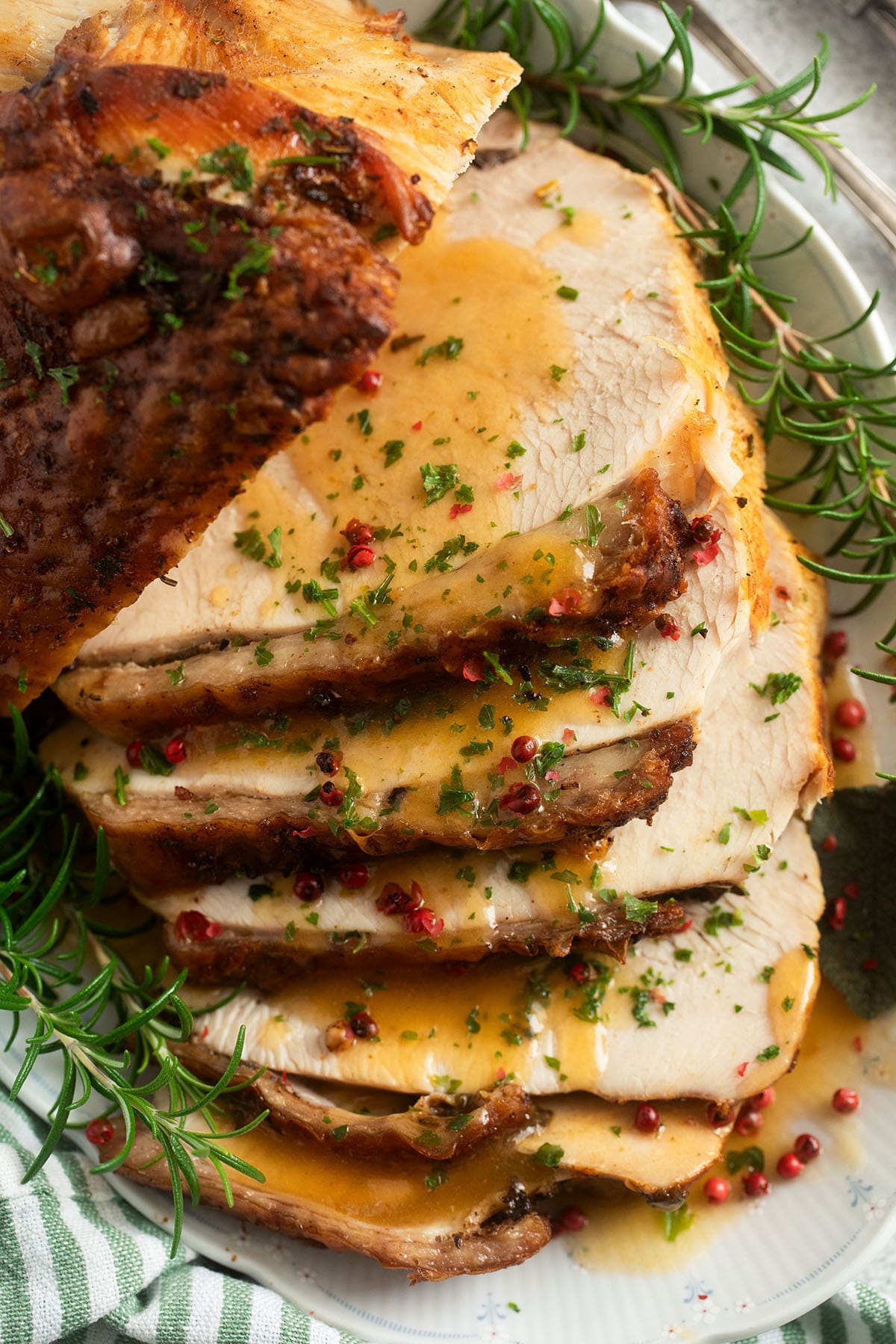
Our tender slow-roasted turkey breast is brined with a medley of aromatic herbs, slathered with seasoned butter, and then roasted low and slow, allowing the flavors to meld and the meat to become incredibly juicy and tender.
Learn a simple technique for preparing turkey breast with crispy skin and juicy, tender meat, and find out how to make a delicious sauce using the roasting juices.
The end result? A mouthwatering, golden brown turkey breast with a delectable, savory taste that's sure to impress your family and friends on Thanksgiving day.
For more slow-cooked turkey recipe ideas, check out our Slow Cooker Whole Turkey, Slow Cooker Turkey Legs, or Pulled Turkey.
Jump to recipe
- ❤️Why does this recipe work?
- ❓How do I roast juicy turkey breast without it getting dry?
- 📋Recipe ingredients
- 👩🏻🍳How to slow-roast turkey breast in the oven?
- 📄General rules on roasting turkey breast
- ⏲️Roasting time for turkey breast
- ❗Expert Tips
- ❓Recipe FAQ
- 🍽️What to serve with a roasted turkey breast?
- 🦃More turkey breast for Thanksgiving
- Slow-Roasted Turkey Breast
❤️Why does this recipe work?
- Tenderness and juiciness: The salt in the brine helps the slow-roasted turkey breast retain moisture during cooking. This results in juicier, more tender meat, preventing it from drying out, especially during longer cooking methods like roasting.
- Enhanced flavor: Brining also infuses the meat with a savory and seasoned taste, making each bite more flavorful.
- Crispy skin: The slow roasting process makes the skin wonderfully crispy, providing a delightful contrast to the succulent meat.
- Depth of flavors: The long cooking time allows the flavors to meld and intensify, creating a well-rounded taste that's deeply satisfying.
❓How do I roast juicy turkey breast without it getting dry?
- Brine the turkey breast: Brining is the best way to ensure the meat stays moist and juicy. As the meat soaks in the brine solution, the salt and any additional herbs and spices are absorbed, infusing the breast with a well-rounded, seasoned taste. This ensures the flavor reaches beyond the surface, resulting in a more delicious and thoroughly seasoned turkey.
- Slow roast the breast: I use a low and slow cooking method, roasting the turkey breast at around 320°F/ 160°C. This gentle heat allows for better control. It is best to use a meat thermometer and remove the meat from the oven when it reaches 160°F/ 71°C, as it continues to cook after removal and will get the safe internal temperature of 165°F/ 74°C during the resting time.
- Adding a bit of liquid to the roasting pan also helps keep the meat moist.
- Try our juicy Bacon-Wrapped Turkey Breast as well.
📋Recipe ingredients
Ingredients for the brine
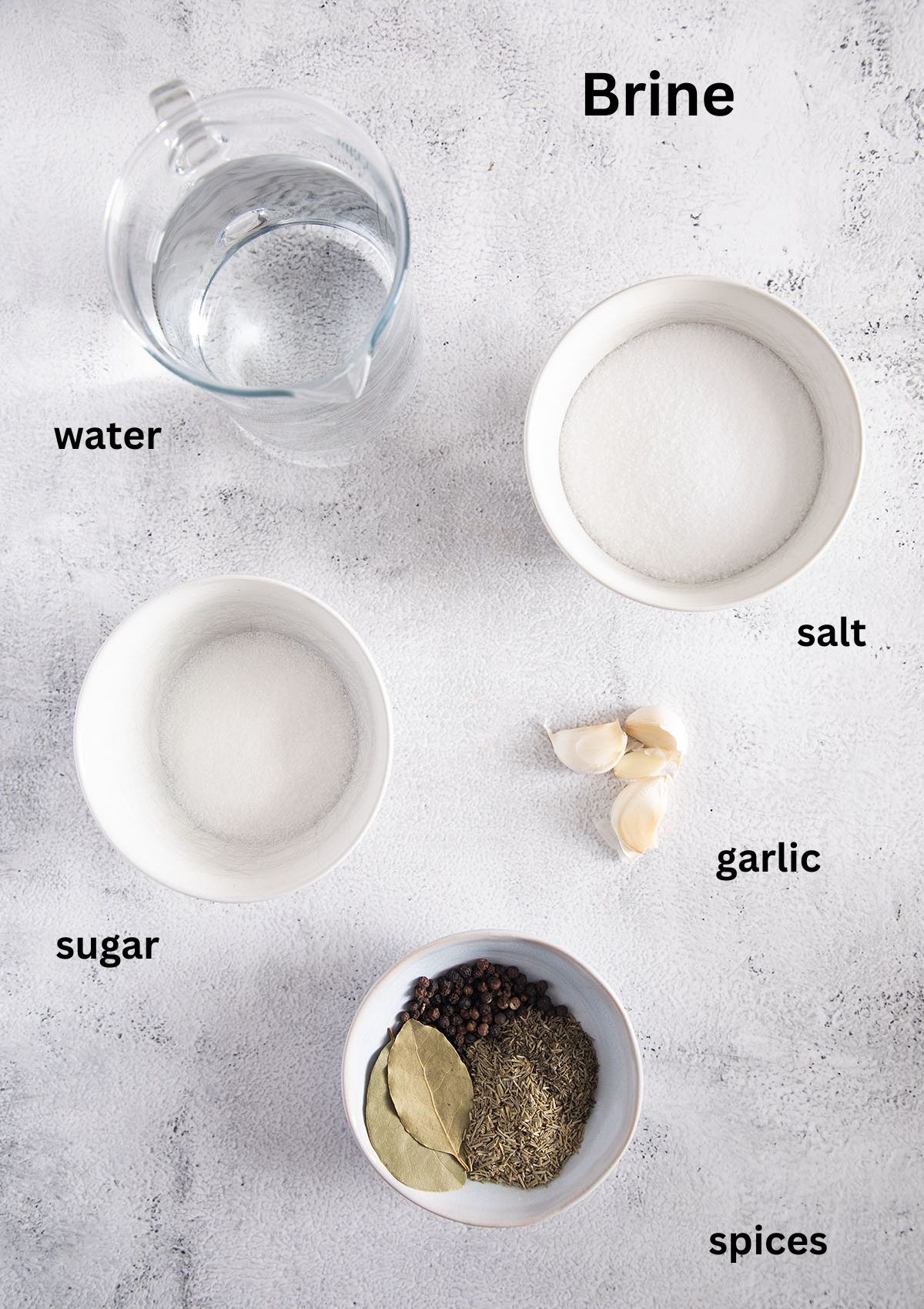
- Water, fine sea salt, white sugar, peppercorns, rosemary, thyme, garlic, and bay leaves.
- You will also need a large container that will fit the piece of meat and all the brine. I used a large, oval, emailed Dutch oven.
Ingredients for the roast
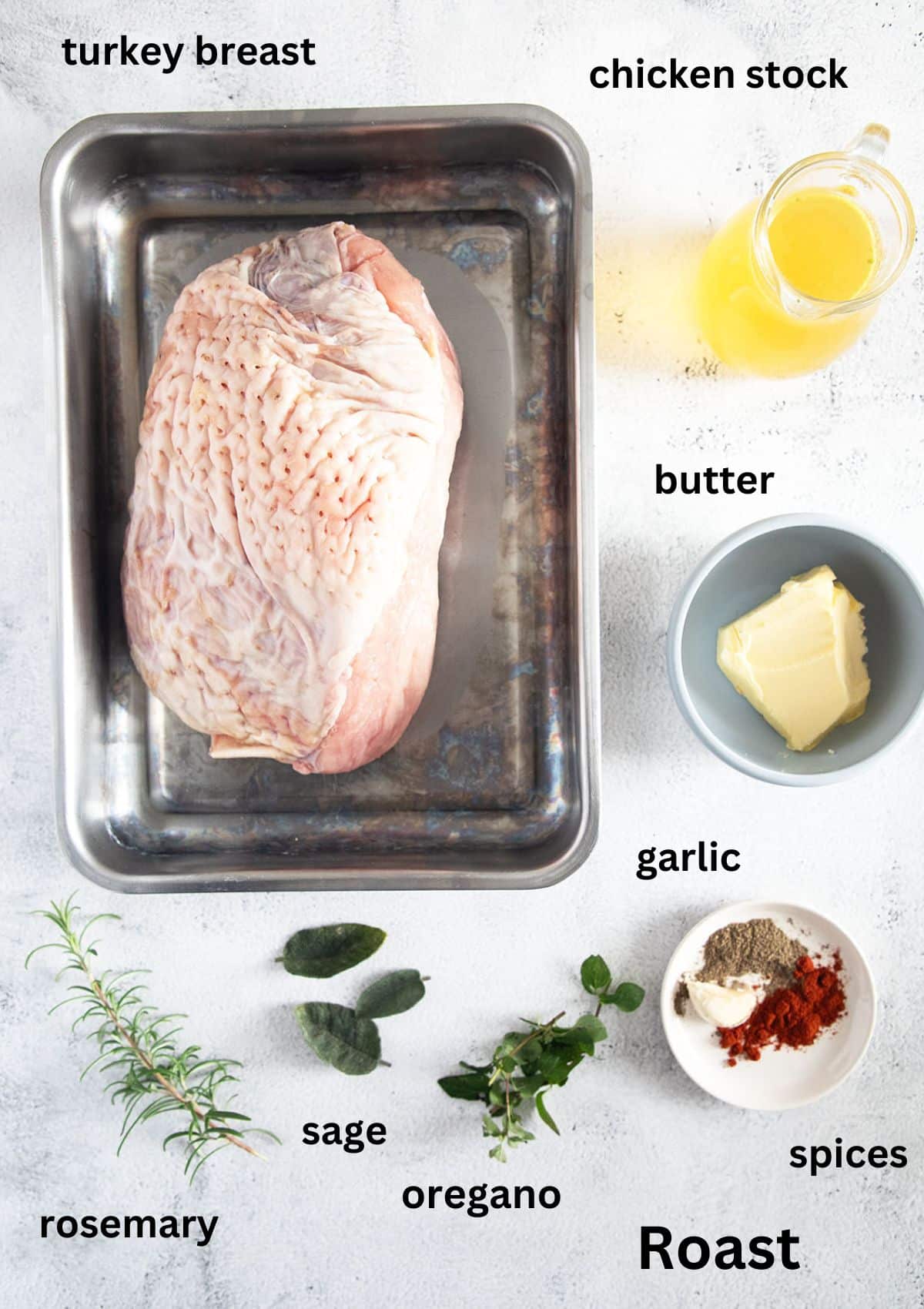
- Turkey breast: You will need half a large boneless breast with its skin on. The size can differ very much from bird to bird. I usually roast only half a breast; it is enough for our family. It weighs typically between 3–4.5 lbs/ 1.3-2 kg.
- Herbed butter: Butter - preferably unsalted because the brine already contains lots of salt, a few small sprigs of fresh rosemary and oregano, 2-3 leaves of sage (depending on size), smoked paprika, fine sea salt, and ground black pepper.
- For the pan: One onion and one cup of chicken stock.
- Gravy: The cooking juices, cornstarch, and cold water.
Variations on the recipe
This slow-roasted turkey breast recipe is incredibly simple, using only a handful of basic seasonings and ingredients. However, as with any basic method, there's room for customization to suit your personal preferences.
- Cooking liquid: Instead of only using chicken stock, consider incorporating white wine, apple cider, or other liquids to infuse different flavors into the meat. If you have it, use turkey broth.
- Spiced butter: I mixed the unsalted butter with fresh herbs, smoked paprika, salt, and pepper, but you could use any spices you like, for instance, Italian herbs or other mixed herbs, curry powder, or any favorite spice mixture or spice rub.
👩🏻🍳How to slow-roast turkey breast in the oven?
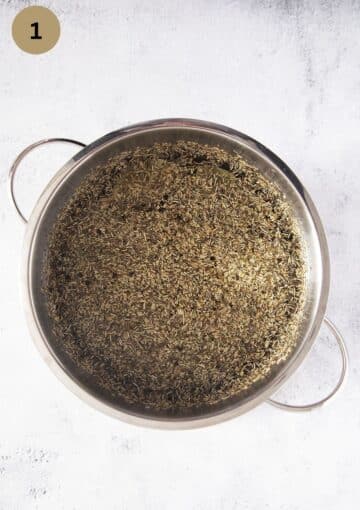
Step 1: Simmer the brine.
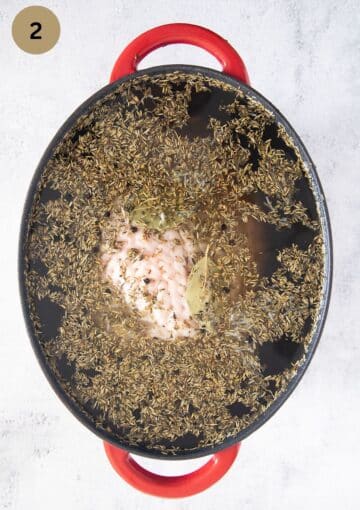
Step 2: Brine the meat in the fridge for 20-36 hours. Bring it to room temperature and dry it well.
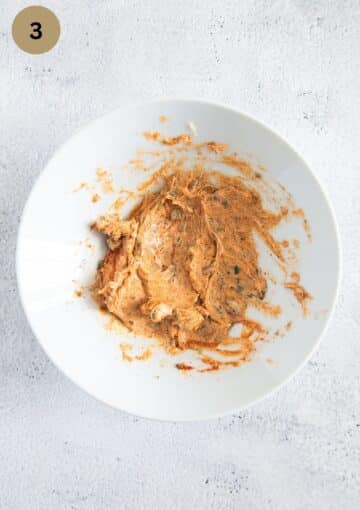
Step 3: Mix the butter with chopped herbs and spices in a small bowl.
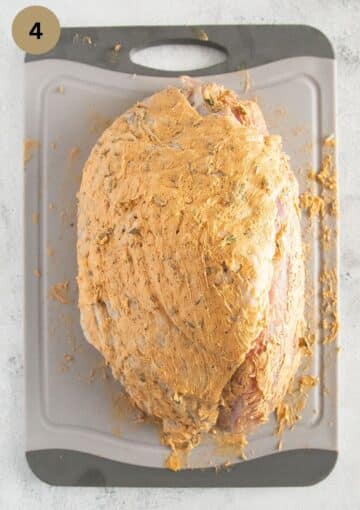
Step 4: Spread the butter onto the breast, including under the skin.
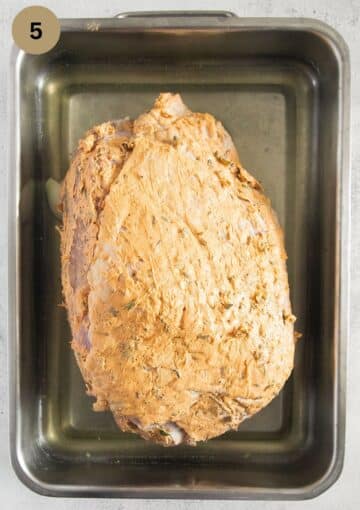
Step 5: Scatter the onion pieces into the tin. Place the breast on top and pour the stock around it.
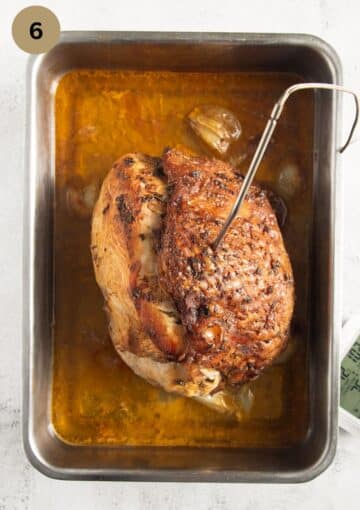
Step 6: Roast until the internal temperature reaches 160°F/ 71°C. Let rest.
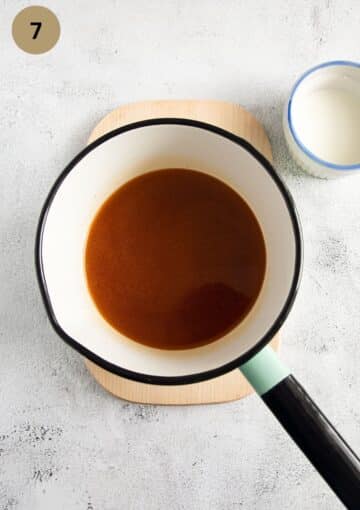
Step 7: Strain pan drippings into a small pot.
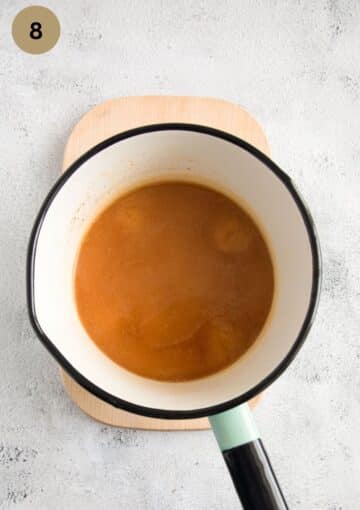
Step 8: Thicken gravy with cornstarch slurry.
📄General rules on roasting turkey breast
- To defrost turkey parts, always use the refrigerator. A large piece needs at least 12-15 hours in the fridge. Larger or bone-in pieces may need more time.
- Remove the meat from the fridge about an hour before cooking to let it reach room temperature.
- Begin checking the meat's internal temperature around 1 hour after starting to cook, depending on its size. Keep checking until it reaches 160°F/ 71°C.
- Let rest for 10-15 minutes before slicing. The internal temperature will increase to 165°F/ 74°C during this time, which is the recommended safe temperature for poultry.
- Using a meat thermometer (the Amazon affiliate link opens in a new tab): The thermometer makes cooking simpler because you don't need to figure out times for different-sized bird parts. Just insert it into the thickest part of the meat, read the temperature, and you'll know when it's done. This guarantees safe, moist, and juicy meat without guesswork.
⏲️Roasting time for turkey breast
The piece I had weighed about 4 lbs/ 2 kg. I roasted it for 10 minutes at 450°F/220°C, then turned the heat down to 320°F/160°C and slow-roasted it for exactly 2 hours until it reached the internal temperature of 160°F/ 71°C.
After 15 minutes of resting time (loosely covered with aluminum foil), the internal temperature reached 165°F/ 74°C, meaning the turkey breast was safe to eat while still being perfectly juicy and not one bit dry.
But the exact cooking time also depends on your oven. Not all ovens are equally precise with temperature. It's essential to be familiar with your oven's quirks and adjust cooking times accordingly.
If you don't use a meat thermometer, check the slow-roasted turkey breast after about 1 hour and 20 minutes by inserting a long stick in the thickest part of the breast. The juices should run clear; if they are still red or pink, continue the cooking process, checking again every 5 minutes or so.
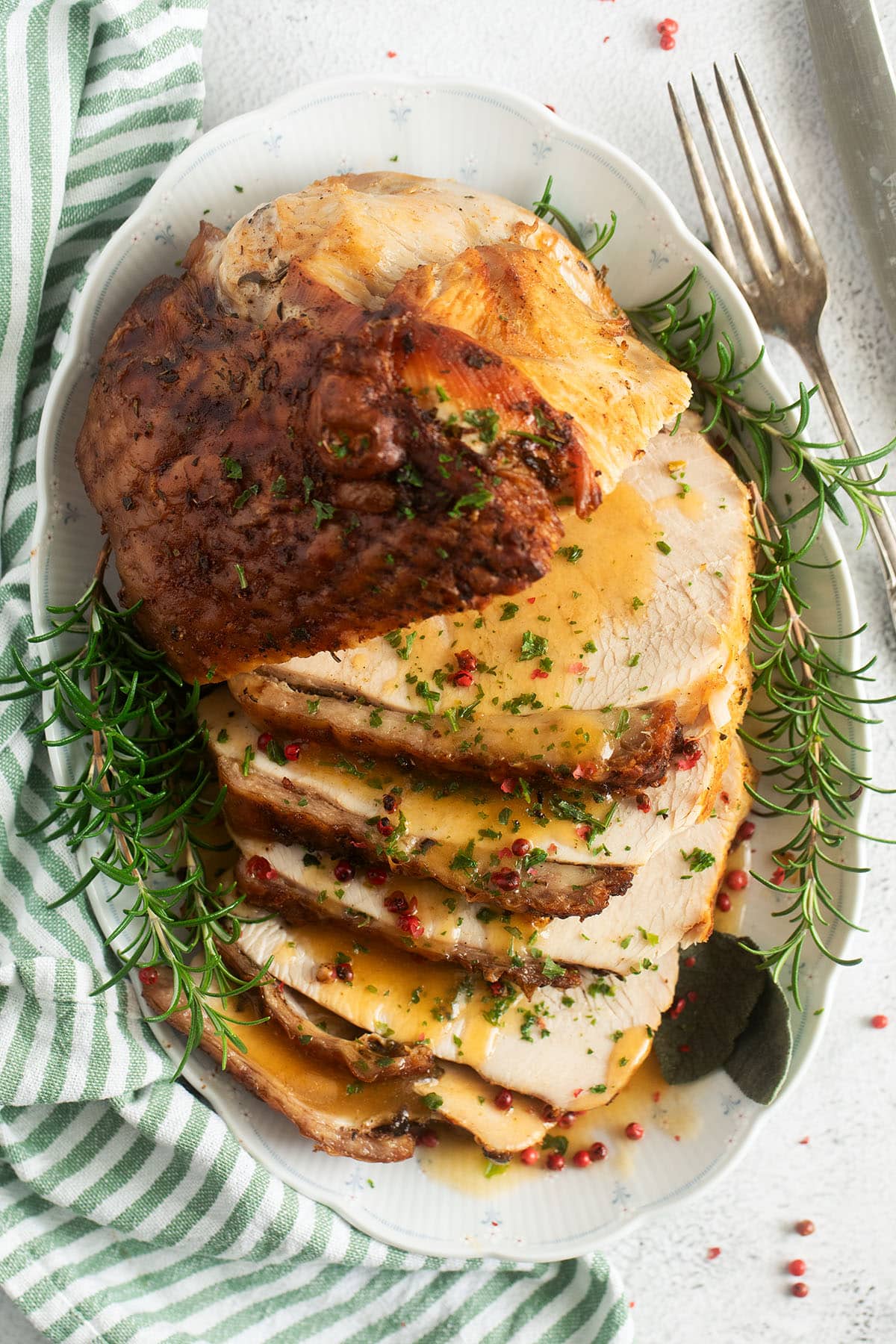
❗Expert Tips
- Salt: I’ve only used fine sea salt to make the brine and never tested this recipe with table salt. Different salts can have varying potency levels, so if you need to use table salt in this recipe, you can use less.
- Reducing the required amount by 2 tablespoons is a helpful guideline, as table salt is generally denser and more concentrated than sea salt. Adjusting the salt quantity ensures your brine maintains the right balance of flavors and seasoning.
- Using a meat thermometer (the Amazon link opens in a new tab) is crucial for this slow-cooked turkey breast recipe. Different cuts and sizes of turkey require varying cooking times, and the thermometer ensures that you hit the proper internal temperature to avoid undercooking, which can be unsafe, or overcooking, which results in dry meat.
- This simple tool takes the guesswork out of the equation, allowing you to consistently achieve perfectly cooked, tender, and flavorful turkey.
- Pat dry: Before rubbing with herb butter, make sure to pat the breast meat dry with paper towels. Dry skin ensures better crisping during roasting.
- Rest before slicing: Allow the turkey breast to rest for about 15 minutes after roasting. This helps redistribute the juices, making the meat more succulent.
❓Recipe FAQ
Sure, but you MUST use a meat thermometer to determine the exact cooking time. Whether you're working with bone-in turkey breast with the wing drumette attached (Frenched breast cut), boneless pieces with or without skin, or a turkey crown, the sizes vary, and bone-in cuts typically require more cooking time. Always use a meat thermometer to ensure your meat is cooked to perfection.
A meat thermometer and an instant-read thermometer (the Amazon link opens in a new tab) differ in how they are used. A meat thermometer is designed to stay in the meat as it cooks slowly, making it ideal for larger cuts and roasts. In contrast, an instant-read thermometer provides a quick temperature reading and is meant for checking the doneness of thinner cuts and for verifying final temperatures at the end of cooking.
You can use any of them for this recipe, though.
Store leftover turkey breast in an airtight container in the refrigerator. It can be kept for 3-4 days. For longer storage, freeze it for up to 2-3 months. Defrost in the fridge and reheat before serving.
Reheat in the oven: Preheat to 325°F/165°C, cover with foil, and heat for 20-30 minutes.
Reheat in the microwave: Use short intervals with a vented cover, stirring between.
Reheat on the stovetop: Slice turkey and heat with broth in a pan, stirring until warm.
🍽️What to serve with a roasted turkey breast?
- Classic side dishes like mashed potatoes with garlic, cranberry sauce, and stuffing.
- Roasted vegetables: Roasted carrots, caramelized Brussels sprouts, or French green beans.
- Other vegetable side dishes: Buttery corn, Cauliflower in White Sauce (without the eggs), Baked Sweet Potato Slices, or Sweet Potato Dauphinoise.
- Salad: A fresh green salad with a zesty vinaigrette or Yogurt Dressing, coleslaw, or Beetroot and Feta Salad.
- Rolls or bread: Try our Yeast Rolls, Cast-Iron Skillet Cornbread, or Yogurt Soda Bread.
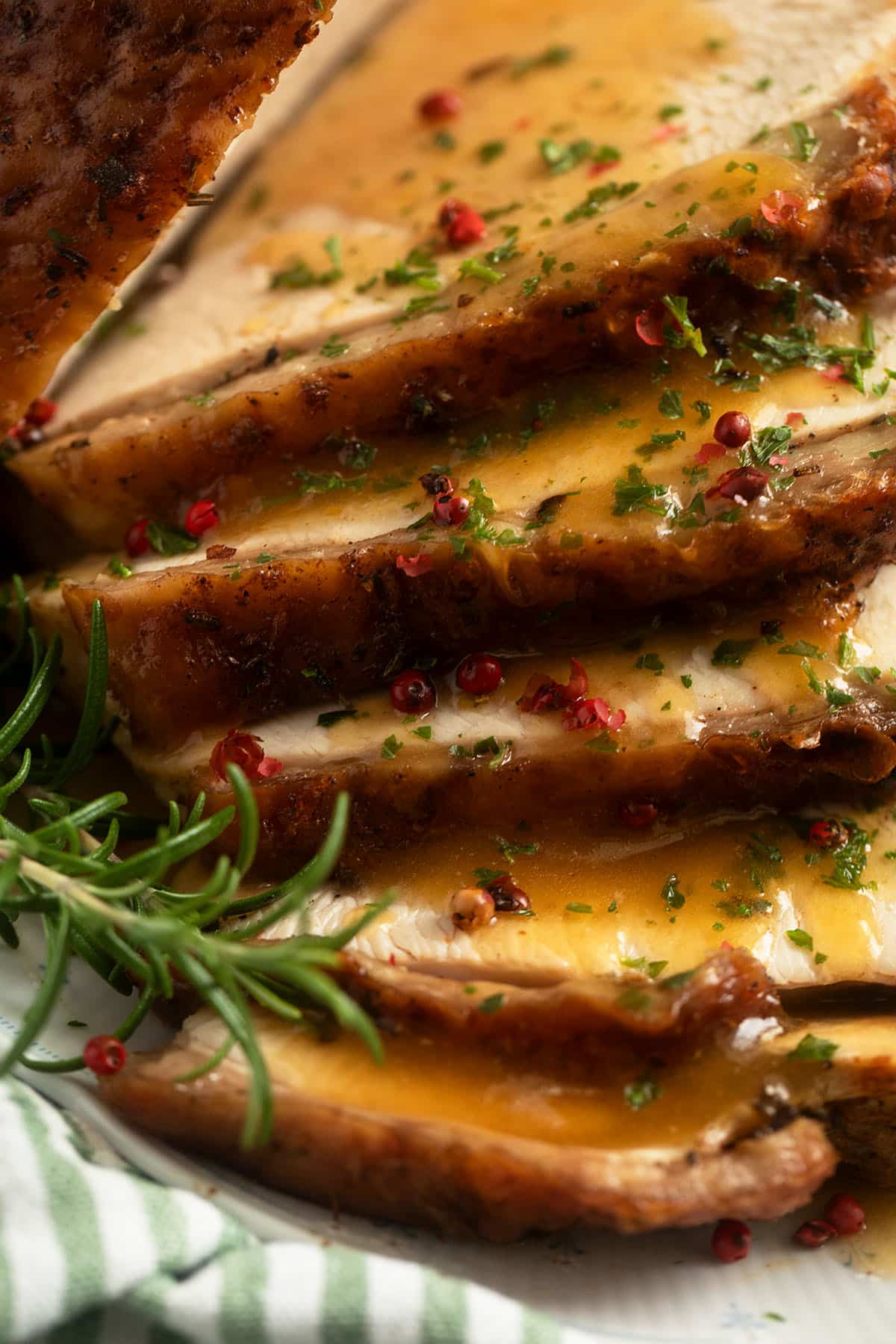
🦃More turkey breast for Thanksgiving
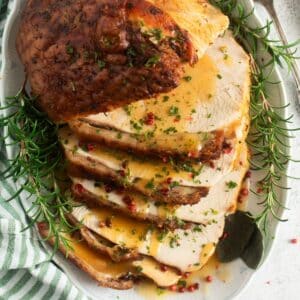
Slow-Roasted Turkey Breast
Equipment
- Large pot
- Large container for brining Note 1
- Roasted tin
- Aluminum foil
- Small saucepan
Ingredients
- 1 turkey breast skin-on, about 3–4.5 lbs/ 1.3-2 kg, Note 2
Brine:
- 8 ½ cups water 2 liter
- ¾ cup fine sea salt 225 g/ 8 oz, Note 3
- ⅓ cup white sugar 70 g/ 2.5 oz
- 4 garlic cloves grated
- 1 tablespoon peppercorns
- 1 tablespoon rosemary
- 1 tablespoon thyme
- 2 bay leaves
Butter:
- ¼ cup unsalted butter 60 g, Note 4
- 1 small sprig rosemary
- 1 small sprig oregano
- 2-3 small sage leaves
- ¼ teaspoon black pepper
- ⅛ teaspoon smoked paprika
Roast and gravy:
- 1 medium onion
- 1 cup chicken stock 250 ml
- 1 ½ tablespoons cornstarch
- 1-2 tablespoons cold water
Instructions
Brine the turkey:
- Make the brine: Heat the water in a large pot. Add salt and sugar and stir to dissolve for a couple of minutes. Add the peppercorns, dried herbs, and grated garlic.8 ½ cups water / 2 liters + ¾ cup fine sea salt/ 225 g + ⅓ cup white sugar / 70 g + + 1 tablespoon peppercorns + 1 tablespoon rosemary + 1 tablespoon thyme + 2 bay leaves + 4 garlic cloves
- Brine turkey: Place the breast into the brining container and pour the liquid on top. Cover and let the liquid come to room temperature; it will take about 30-40 minutes. Once cool, refrigerate the turkey breast for at least 20 and up to 36 hours.1 turkey breast
- Room temperature: Remove the meat from the container and pat it dry with paper towels. Let it come to room temperature before roasting (30-40 minutes).
Roast turkey breast:
- Preheat the oven to 450°F/220°C.
- Butter: Mix the soft butter with the finely chopped herbs and spices in a small bowl.¼ cup unsalted butter / 60 g + 1 small sprig rosemary +1 small sprig oregano +2-3 small sage leaves + ¼ teaspoon black pepper + ⅛ teaspoon smoked paprika
- Rub meat: Ensure the meat is dry and spread the butter onto the breast, including under the skin. If the skin is still wet, it will be hard to spread the butter evenly.
- Assemble: Peel and cut the onion into wedges or thick slices. Arrange them in the roasting tin and place the turkey breast on top. Pour the chicken stock around the meat.1 medium onion + 1 cup chicken stock / 250 ml
- Roast the turkey at a high temperature for 10 minutes.
- Slow roast: Reduce the oven temperature to 320°F/160°C and roast the turkey breast until it reaches the internal temperature of 160°F/ 71°C. The exact roasting time depends on the cut and size of the turkey breast, so using a meat thermometer is the best way to ensure that the meat is safely cooked without being dry. I needed exactly 2 hours for a 4 lbs/ 1.9 kg piece.
- Rest: Remove the roast from the oven, cover it with a foil tent, and let it rest for about 15 minutes. During this time, the internal temperature will rise to 165°F/ 74°C, which is the safe internal temperature for turkey.
Gravy:
- Make the gravy while the turkey rests.
- Strain the cooking liquid into a small saucepan.
- Mix cornstarch with cold water to obtain a thick yet pourable slurry.1 ½ tablespoons cornstarch + 1-2 tablespoons cold water
- Thicken gravy: Bring the liquid to a simmer and whisk in the cornstarch mixture. Let the gravy bubble shortly; it will thicken almost immediately.
Notes
- Brining container: Something that fits in the refrigerator and is large enough to hold the meat and the brine. I used a large, oval, emailed Dutch oven.
- Turkey: The piece I had weighed 4 lbs/ 1.9 kg. I roasted it for 10 minutes at 450°F/220°C, then turned the heat down to 320°F/160°C and slow-roasted it for exactly 2 hours until it reached the internal temperature of 160°F/ 71°C. After resting, the internal temperature will rise to 165°F/ 74°C.
- Salt: I only use fine sea salt to make the brine; I have never tested this recipe with table salt. If you have to use table salt, use less. Table salt is more potent, so reduce the amount by 2 tablespoons to keep the flavors right.
- Butter: It's best to use unsalted butter in this recipe because the meat is already salty from the brine.

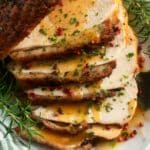
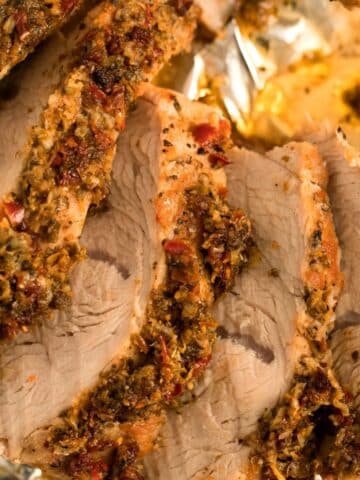
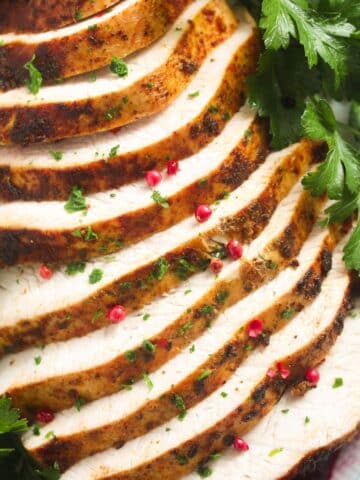
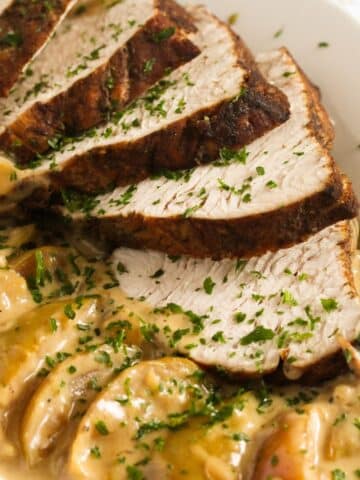
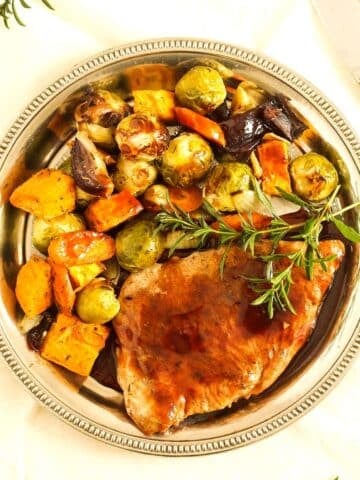
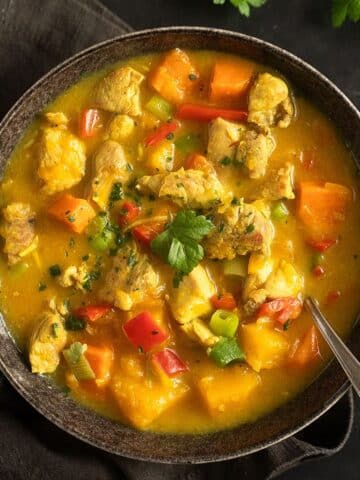
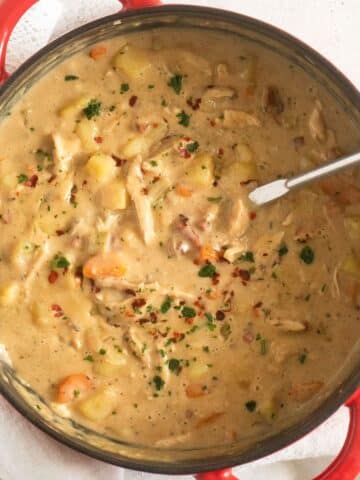
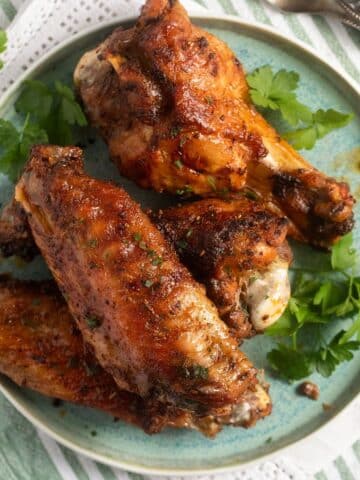
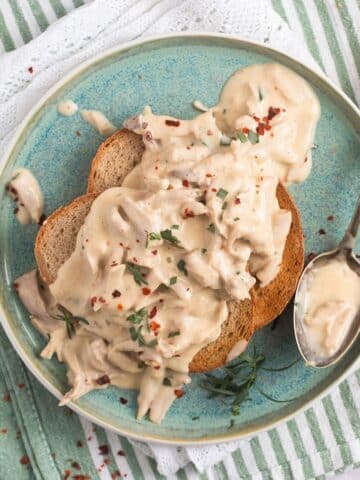

Karen (Back Road Journal) says
We are always out of town for Thanksgiving but I enjoy cooking just a turkey breast when we return home for turkey sandwiches. Your cooking method sounds perfect.
Adina says
Hi Karen, nice to hear from you again. You should try this recipe, it's really good.